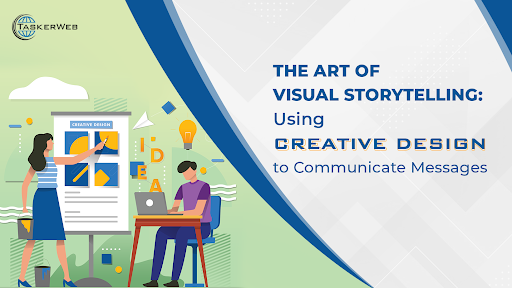In today's fast-paced and information-rich world, capturing the attention of your audience and effectively communicating your message is more challenging than ever. Amidst the sea of content, visual storytelling has emerged as a powerful tool to cut through the noise and leave a lasting impact. By harnessing the potential of creative design, businesses and individuals can convey complex messages in a captivating and engaging manner.
With this blog, we aim to shed light on the art of visual storytelling and how creative design services can effectively communicate messages through captivating visuals.
The Power of Visual Storytelling
Human beings are wired to connect with stories. Visual storytelling taps into this innate human tendency, leveraging the power of visuals to evoke emotions, convey information, and leave a lasting impression. While written or spoken words are undoubtedly important, visuals have the unique ability to capture attention and communicate complex ideas concisely and compellingly.
Creative Design: Bringing Stories to Life
Creative design serves as the bridge that brings stories to life, transforming abstract concepts and messages into visually captivating narratives. Designers employ a range of techniques and mediums to create visuals that resonate with the target audience and effectively communicate the intended message. Here are some key approaches within creative design that contribute to the art of visual storytelling:
Infographics
Infographics are a powerful tool for presenting complex information in a visually appealing and easily understandable format. By combining data, statistics, and illustrations, infographics break down complex concepts into visually striking graphics. They filter information into bite-sized, visually appealing chunks, allowing viewers to grasp key ideas at a glance. Infographics make it easier for the audience to comprehend and remember the information being presented, enhancing engagement and retention.
Multimedia Storytelling
With the advent of digital technology, multimedia storytelling has gained significant popularity. This approach combines various media elements, such as visuals, audio, and interactive features, to create immersive narratives. Videos, animations, and interactive graphics engage multiple senses, enabling a more dynamic and memorable storytelling experience. Multimedia storytelling allows for greater interactivity and engagement, as the audience becomes active participants in the narrative. Through multimedia, stories come to life, captivating viewers and leaving a lasting impression.
Illustrations
Illustrations add an artistic and creative touch to visual storytelling. They can convey emotions, depict scenes, and simplify complex ideas. Whether created through hand-drawn techniques or digital artwork, illustrations complement the narrative by visually enhancing the storytelling experience. Illustrations can capture the attention of the audience, evoke specific moods or reactions, and provide visual cues that guide the viewer through the story. They bring a unique aesthetic to the narrative and contribute to its overall impact.
Employing these techniques makes visual storytelling a multidimensional experience. The use of infographics, illustrations, and multimedia elements enhances the effectiveness of the storytelling process, enabling messages to be conveyed compellingly and engagingly. Impactful visuals serve as a powerful tool for transforming abstract ideas into visual narratives that resonate with the audience, making the storytelling experience more impactful and memorable.
Crafting Effective Visual Narratives
To create impactful visual narratives, several key elements should be considered to ensure that the message is effectively communicated and received by the audience. Let's delve deeper into these elements:
Understanding the Audience
Successful visual storytelling begins with a deep understanding of the target audience. It is crucial to research and analyze their needs, interests, and preferences. By gaining insights into their demographics, psychographics, and motivations, designers can tailor the visual elements to resonate with the audience. Understanding what captures their attention and speaks to them emotionally allows for the creation of visuals that effectively convey the intended message.
Clarity and Simplicity
Visual storytelling is most effective when complex ideas are simplified and conveyed through clear and concise visuals. Designers should strive to eliminate unnecessary clutter and focus on the core message. By distilling information into its essential components and using visual techniques such as hierarchy, visual cues, and minimalism, the audience can easily grasp and understand the story being told. Striking the right balance between simplicity and creativity is crucial to avoid overwhelming the audience while maintaining their engagement.
Consistency and Branding
Visual or multimedia storytelling should align with the overall brand identity and maintain consistency throughout. Incorporating brand colours, typography, and design elements ensures that the visual narrative becomes an extension of the brand itself. Consistency in visual aesthetics reinforces brand recognition and helps build a cohesive visual identity. By adhering to brand guidelines, designers can create visuals that are not only visually appealing but also reinforce the brand's values, personality, and positioning.
Emotion and Engagement
Effective visual storytelling evokes emotions and fosters a connection with the audience. By incorporating elements that resonate on an emotional level, the narrative becomes more engaging and memorable. Designers can achieve this by using relatable characters, vibrant colours, evocative imagery, and storytelling techniques that elicit specific emotions. By appealing to the audience's emotions, whether it's through humour, empathy, inspiration, or nostalgia, the visual narrative becomes more relatable and leaves a lasting impact on the viewers.
Visual Storytelling Steps to Avoid
- Viral memes. While it may be alluring to follow a recently popular meme, the internet moves more quickly than any marketing organization. Your viral meme material probably will not be seen by many people by the time you put it out.
- Do not attempt to force the shoe to fit if it does not! More often than not, using this strategy will cause your story to sink rather than swim since audiences are more astute than ever.
- Put style before substance. If a visual tale is not engaging, what is the point? The narrative should be the primary focus, not the images.
- Repackage the same narrative into every visual medium available (unless there is a natural fit). Most brands will make a judgment decision on this. Repurposing the same material again can negatively impact how your audience perceives your business, thus it is best to avoid doing it.
- Use more images. Your target audience should not become perplexed or distracted by your message. Make it as brief as you can for better comprehension.
- Just to have a complete visual tale, remove music and text. Do not disregard audio and text in favour of keeping everything visual.
5 Ideas for Mastering Visual Storytelling
1. Build a Solid Structure
Every narrative has a hero, a difficulty to overcome, a quest to complete the difficulty, and what we would call a "happily ever after." As the tale builds to its conclusion, make sure your designs adhere to this framework.
2. Give Life to the Characters in Your Story
Any story's characters are its lifeblood. To make characters engaging and appealing, use striking images, motion graphic films, or animated GIFs. Using emotions during the character creation process can help you build characters in your tale who are relevant and simple to relate with.
3. Show
If used correctly, whether as an image, infographic, or video, Do not express Visuals may help us express our story swiftly, with impact, and with emotion. Use interactive, captivating data visualizations, such as charts or dynamic graphs, rather than making elaborate graphics, to assist users understand and remember the information offered.
4. Draw in Focus
When describing your product's history, features, advantages, walkthroughs, etc., employ interactive content, gamification, or motion visuals to grab the audience's attention. To guarantee the message has a significant impact, make it interesting and provide adequate white space.
5. Emphasis on UX
Great design's UX is really where its beauty lies. Make sure you create responsive designs for mobile users as well as using understandable typography. It is crucial since Google's ranking heavily considers responsive design.
Making your story more comprehensible and captivating should be the main consideration in every choice you make. Choosing a presentation design element that is dynamic or eye-catching may sound enticing, but if it does not help the story at all, it could only end up being a distraction.
Conclusion
Finally, visual storytelling is a potent technique that may transport viewers to a different setting, arouse feelings, and leave them with a lasting impression. You may tell a fascinating and memorable tale that interests your audience by carefully selecting and exploiting visual elements like colour, composition, lighting, and perspective.
The use of conventional media like film and photography is not the only form of visual storytelling. Nevertheless, it may be used in a variety of contexts, such as graphic design, social media, and digital marketing. Understanding the fundamentals of visual storytelling can help you communicate your brand's message clearly, engage your audience, and ultimately expand your business.
Connect with TaskerWeb professionals, a multi-faceted, efficient, economical, transparent and flexible organization. We are committed to customer satisfaction and results with our user-friendly digital solutions for any type of business. Book our exclusive trial today and experience change!








_.jpg)

